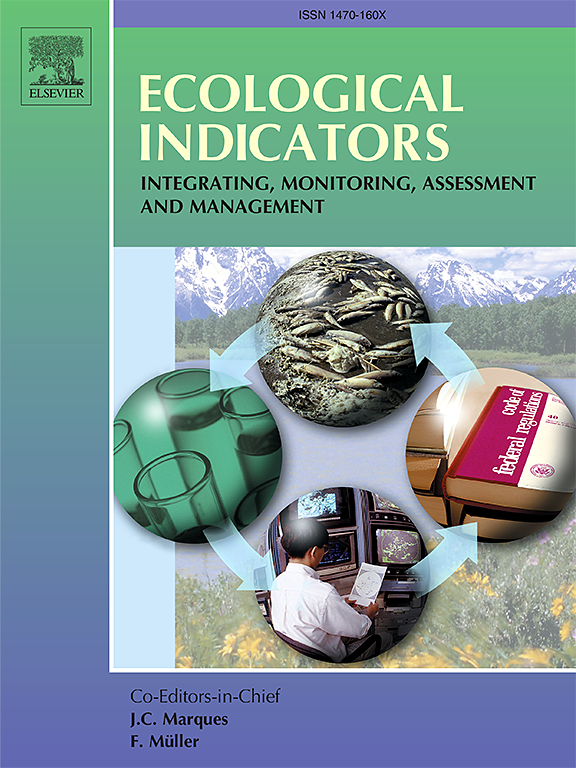Comparison of vegetation responses to diverse water sources in the Yangtze River Basin: Insights from meteorological, hydrological, and agricultural drought
IF 7
2区 环境科学与生态学
Q1 ENVIRONMENTAL SCIENCES
引用次数: 0
Abstract
Understanding the intricate link between water availability and vegetation growth is crucial for preserving ecosystem vitality and facilitating global carbon cycling. The Yangtze River Basin (YRB) features vast subtropical forests, which are vital for global hydrological, carbon, and energy flows. Investigating the influence of the water supply on vegetation dynamics in this basin is crucial, particularly in light of the challenges posed by climate change. However, the response of vegetation to different water sources remains poorly understood. To address this gap, this study explores the influence of precipitation, surface runoff, and soil water on vegetation growth in the YRB via hydrologic modelling and remote sensing data from 2003 to 2021. The results revealed a decreasing trend in drought-prone areas. The overall vegetation growth has progressively improved despite challenges posed by water scarcity. More areas in the YRB are affected by water shortages than surpluses in terms of vegetation growth. During the growing season, vegetation is primarily affected by water shortage, although in exceptional cases, it is constrained by excess water, which typically occurs during the nongrowing season. In the upper and middle Jinsha River Basin, vegetation growth is primarily restricted by water surpluses, while in the middle and lower YRB, constraints commonly arise from water deficits. Additionally, surface runoff and soil moisture play more significant roles in influencing vegetation growth than precipitation. By revealing the dynamics of the vegetation–water correlation, our research aims to provide valuable insights for managing the dynamic balance between water and vegetation in subtropical regions.
长江流域植被对不同水源的响应比较:来自气象、水文和农业干旱的启示
了解水分供应和植被生长之间的复杂联系对于保持生态系统活力和促进全球碳循环至关重要。长江流域拥有广阔的亚热带森林,对全球水文、碳和能量流动至关重要。调查供水对该流域植被动态的影响至关重要,特别是考虑到气候变化带来的挑战。然而,植被对不同水源的响应仍然知之甚少。为了弥补这一空白,本研究通过2003年至2021年的水文建模和遥感数据,探讨了降水、地表径流和土壤水分对长江三角洲植被生长的影响。结果表明,在干旱易发地区,该指数呈下降趋势。尽管水资源短缺带来了挑战,但总体植被生长已逐步改善。就植被生长而言,长江三角洲受水资源短缺影响的地区多于受水资源过剩影响的地区。在生长季节,植被主要受到缺水的影响,尽管在特殊情况下,它受到过量水的限制,这通常发生在非生长季节。在金沙江中上游,植被生长主要受富余水的制约,而在中下游,植被生长主要受亏水的制约。地表径流和土壤湿度对植被生长的影响比降水更为显著。通过揭示植被与水的动态关系,本研究旨在为管理亚热带地区水与植被的动态平衡提供有价值的见解。
本文章由计算机程序翻译,如有差异,请以英文原文为准。
求助全文
约1分钟内获得全文
求助全文
来源期刊

Ecological Indicators
环境科学-环境科学
CiteScore
11.80
自引率
8.70%
发文量
1163
审稿时长
78 days
期刊介绍:
The ultimate aim of Ecological Indicators is to integrate the monitoring and assessment of ecological and environmental indicators with management practices. The journal provides a forum for the discussion of the applied scientific development and review of traditional indicator approaches as well as for theoretical, modelling and quantitative applications such as index development. Research into the following areas will be published.
• All aspects of ecological and environmental indicators and indices.
• New indicators, and new approaches and methods for indicator development, testing and use.
• Development and modelling of indices, e.g. application of indicator suites across multiple scales and resources.
• Analysis and research of resource, system- and scale-specific indicators.
• Methods for integration of social and other valuation metrics for the production of scientifically rigorous and politically-relevant assessments using indicator-based monitoring and assessment programs.
• How research indicators can be transformed into direct application for management purposes.
• Broader assessment objectives and methods, e.g. biodiversity, biological integrity, and sustainability, through the use of indicators.
• Resource-specific indicators such as landscape, agroecosystems, forests, wetlands, etc.
 求助内容:
求助内容: 应助结果提醒方式:
应助结果提醒方式:


